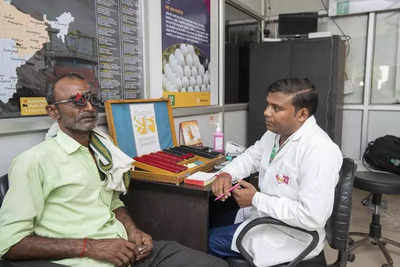Eyes OK Please: Bridging vision gap among truckers

Behind every Amazon parcel that arrives at the door lies a vast logistics network which relies on a nine million-strong workforce of truck drivers. While they hurtle through the country's highway network carrying everything from vegetables to medicine, truckers remain grossly under-paid, face constant police harassment, and are bereft of basic health benefits. Now, a recent intervention has taken care of one of the truck driver's most critical needs — his eyesight.
As of this year, a total of one million truck drivers have been given free eye check-ups and, if needed, corrective spectacles, also free. The correlation between better vision and road safety is undeniable, says RN Mohanty, head of Sightsavers India, a non-profit organisation which started this focused intervention a few years ago.
Founded in 1966, Sightsavers is committed to improving optic health in marginalised communities and advocating for people with disabilities. "This programme hits two bottom lines — vision as well as road safety," adds Mohanty. "It is difficult to prove the correlation between accidents and vision, but what we are doing now is pre-empting things by at least avoiding one of the possible reasons. Most interventions happen post-accident."
Sightsavers launched this programme after it had analysed data collected at its urban centers and found that many of those registering wrote their profession as truck driver. "From that we got a sense that this community needs us," says Mohanty. This led to a micro-study in the Gujarat-Rajasthan corridor which revealed that there truly was a problem — almost half the drivers on the road needed corrective lenses, either for long-distance or near vision. Many drivers knew they had blurry vision but were afraid to reveal this to their employers for fear of losing their jobs — a stigma that even taxi drivers were facing when interviewed in a focus group in Kolkata.
"Some drivers openly told us that they had accidents due to their poor vision, but they didn't want to report it," says programme coordinator Charles Dickson. "Many truckers were not able to drive at night because of blurred vision. We are now getting testimonials from the ground that their families are also happier because this reduces their time away from home."
Given the fleeting and mobile nature of the truck driver's work and his time pressures, Sightsavers' paperless programme has been designed in such a way that if the driver has been tested at a checkpoint in, say, Navi Mumbai and are travelling back north, you could receive your eyeglasses in Kanpur. There are now 26 static locations along the highways where the driver can be screened, either at the ‘transport nagar' hubs where vehicles are loaded and unloaded, or near a toll plaza or a highway dhaba, where truckers routinely stop to eat and rest. The screening is done quickly because the drivers are digitally tracked by their employers and if they halt for longer than 15-20 minutes outside their rest stops, they are pulled up. Gradually, the stigma of wearing spectacles is receding, and the fleet company owners are themselves realizing the benefits of sending the drivers to get their eyes checked up.
Although truck drivers form the backbone of India's logistics sector, their working conditions leave much to be desired, suggest road safety advocates. The health of a freight cargo driver has dire and far wider ramifications which impacts highway passenger traffic at large. However, change is slow in what is a largely unregulated and unorganised sector. "In our view, this falls among the worst working conditions in the country right now, possibly just above manual scavenging," says Piyush Tiwari, founder and CEO of SaveLife Foundation, a non-profit enterprise committed to saving lives on roads in India. "There are multiple taxes paid by freight companies, so a small percentage of that should be used to give the drivers benefits, roadside amenities."
According to a survey conducted by them a few years ago, 53% of the drivers earn from Rs 10,000 to Rs 20,000 per month, and the average age is 36 years which means they have families to support. Their living conditions are abysmal with no standardisation in wages, absence of social security and no incentives to complete a trip on time. On an average, respondents drive for nearly 12 hours in a day and cover a distance of 417 km daily. Almost 50% of the respondents surveyed said they drive vehicles even if they are feeling fatigued or sleepy, and many said they take some kind of drugs while on the road. Currently, the driver to truck ratio is below 750 per 1,000 which means that those employed in the sector are always overworked.
"When we travel, it can be anywhere from eight to 14 hours," says 36-year-old Praveen Kumar from the National Capital Region, who recently got corrective glasses through the programme. "We have to sleep in the car. It would be nice to have some mandated rest stops and it would also be nice if the police did not trouble us."